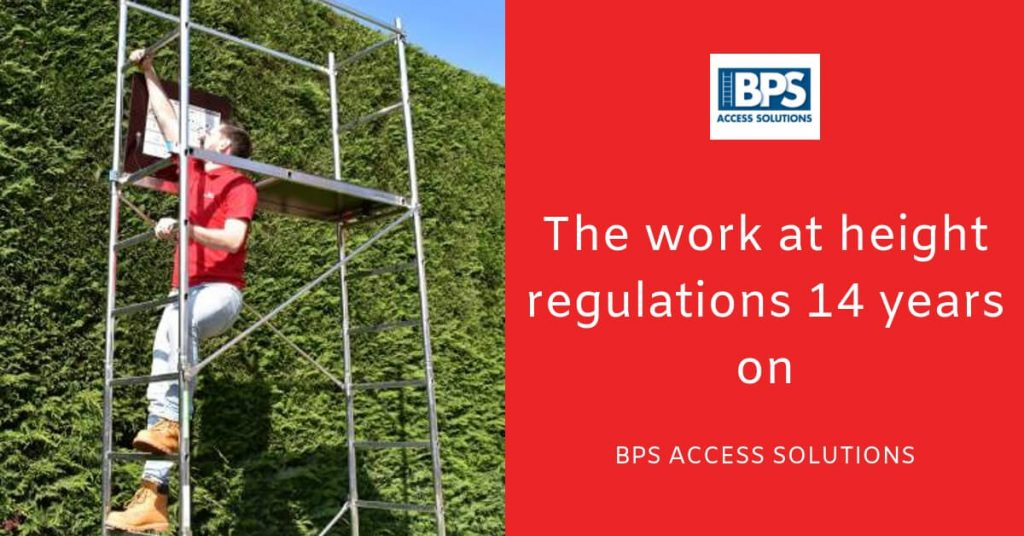Working at height regulations
To work at a height means to work at a level where there is a risk of falling a distance that could cause personal injury. This counts as elevated areas such as a roof, a scaffold or a type of raised platform. It can also refer to areas on the ground near a large drop, such as working near a deep pit.
To maintain the safety, the UK Government established working at height regulations which look out for the well-being of contracted people. Any company you work for has to adhere to the UK’s working at height legislation and take on the responsibilities of installing preventative measures, whether that means providing equipment or training. Even so, falling from a height measures a shocking 35% of all workplace fatalities, and this is one of the main reasons for this blog post.
The set of regulations we’ll be going over are the Work at Height Regulations 2005. These regulations impose duties on employers, as well as anyone who oversees the work. All work at height must be properly planned, supervised and carried out by competent, trained individuals.
Work at Height Regulations 2005 – Employer Responsibilities
The following are the responsibilities of the employer under this working-at-height legislation.
Risk Assessment
Before any work is done at the height, employers are required to do a risk assessment of the work area. This is done in the following steps:
- Identification of the Hazard – First, the employer has to conduct a search and identify any possible hazards for the workers. This could be anything from unstable working surfaces to the risk of falling objects. It could also consist of incoming weather conditions that could make work difficult.
- Identify who may be harmed – After the hazard is identified, these working at height regulations mandate that you identify who may be harmed by said hazards. Not only is it required to screen who may be harmed on the worksite, but also beneath it.
- Evaluate the level of risks – Once the risks are identified, they are ordered in level of severity and likelihood. Each risk must have a preventative level put in place, with the more severe ones likely requiring additional equipment.
- Record the Findings – All findings must be recorded and communicated to the relevant employees as per the working at height legislation.
- Regular updates – The risk assessment isn’t a one-off, but a regularly scheduled thing that happens throughout the work project, so as not to be caught by unforeseen developments.
Planning and Organising
It might sound odd, but an employer is required to ensure to avoid working at a height whenever it’s possible. Where working at a height cannot be avoided, however, there should be a plan in place determining the specifics on how work will be carried out, the equipment needed and how long it will take.
Everyone that will be working at that height will be properly trained in the use of the equipment, as well as the system put in place to maintain the safety measures chosen for the work project, as per the working at height regulations.
On top of that, employers have to plan for emergencies and rescues should an accident occur.
Eliminating Falls plus Preventative Measures
Where falls cannot be eliminated, this working at height legislation mandates that preventative measures be installed instead:
- Avoid Working at Height – Plans will revolve around working at a height as little as possible.
- Correct Equipment – Appropriate equipment should be used for working at a height. This can be anything from a scaffold tower to a mobile elevating platform.
- Fall Prevention Measures – These measures are to modify the environment to make it safer to work. This can be anything from guardrails, to work restraint systems that fasten you to a strong support.
- Fall Mitigation – If there’s still a risk of a fall, then the employer is required to install measures such as safety nets and airbags.
- Emergency Procedures – Even with preventative and mitigative measures, if a fall or the breakdown of vital safety equipment occurs, there should be emergency procedures in place.
- Regular Inspections and Maintenance – Work equipment should be inspected, tested and maintained regularly, to ensure that they are working at its maximum efficiency and in safe condition.
Competency Check
Employers have the responsibility to ensure that all employees involved in working at a height have the required competency. The competency of an employee can be determined in the following ways:
- Training – Employees should be trained in not only their job but the guidelines of these working at height regulations.
- Selection of Equipment – Employees should be trained in the use of work equipment, such as ladders, scaffolding and personal fall protection systems.
- Risk Assessment – Employees should understand both the findings of the risk assessments and the measures put in place as per the working-at-height legislation.
- Emergency Procedures – Workers should be trained in what to do should an emergency happen.
- Regular Drills – When life is at risk, it’s common to have regular drills until the skills required whilst working at height are second nature.
Employee Responsibilities
It’s not just employers, but employees that have to follow guidelines when it comes to this particular Working at Height Legislation.
- Training – Employees are required to learn the proper use of equipment provided to them, as they will be taught to be used not only efficiently, but safely.
- Cooperation with Employers – Employers are bound by legal obligations, and employees must respect and accommodate this.
- Report Unsafe Conditions – If an employee finds that there are things in their workplace contributing to unsafe conditions, these should be reported to a supervisor.
- Follow Precaution – Essentially, this means an employee must never improperly misuse his safety equipment. This goes against the working at height regulations and their goal of keeping everyone safe.
Conclusion
We hope this properly fleshes out the working at height legislation of the UK. All of BPS’ equipment comes with a high degree of safety and craftsmanship to ensure the safety of those working at height.
No related posts.



